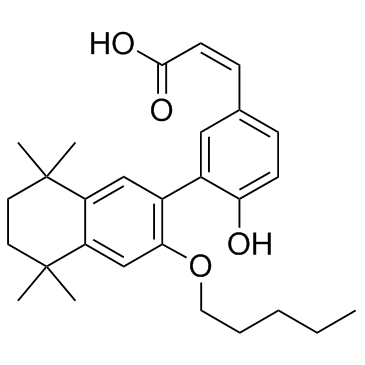| Description |
UVI 3003 is a highly selective antagonist of retinoid X receptor (RXR), and inhibits xenopus and human RXRα in Cos7 cells, with IC50s of 0.22 and 0.24 μM, respectively.
|
| Related Catalog |
|
| Target |
IC50: 0.22 μM (Xenopus RXRα, in Cos7 cells), 0.24 μM (Human RXRα, in Cos7 cells)[1]
|
| In Vitro |
UVI3003 inhibits the activity of xenopus and human RXRα, with IC50s of 0.22 and 0.24 μM, respectively. UVI3003 fully activates xPPARγ with an EC50 of 12.6 μM, and is almost completely inactive on hPPARγ and mPPARγ[1]. UVI 3003 (10 μM) does not change the proliferation rate of extraocular muscles (EOM)-derived or LEG-derived EECD34 cells. UVI 3003 causes a 65.4% difference in EECD34 cell fusion and desmin expression[2].
|
| Cell Assay |
At ∼30-40% confluence cells are treated with vehicle (ethanol), all-trans retinoic acid (1 μM), the RAR inverse agonist BMS493 (10 μM), or the RXR antagonist UVI 3003 (10 μM) for 24 h in proliferation media with a final concentration of ethanol at 0.1% for all treatments. At the end of the 24-h treatment cell proliferation rates are assessed[2].
|
| References |
[1]. Zhu J, et al. The unexpected teratogenicity of RXR antagonist UVI3003 via activation of PPARγ in Xenopus tropicalis. Toxicol Appl Pharmacol. 2017 Jan 1;314:91-97. [2]. Hebert SL, et al. Effects of retinoic acid signaling on extraocular muscle myogenic precursor cells in vitro. Exp Cell Res. 2017 Dec 1;361(1):101-111.
|
